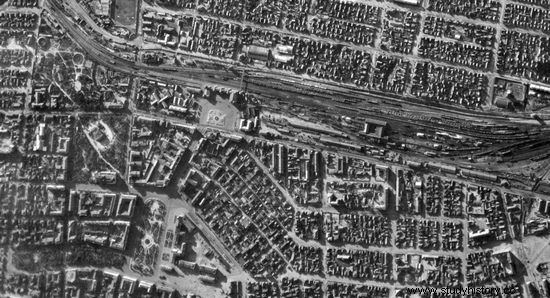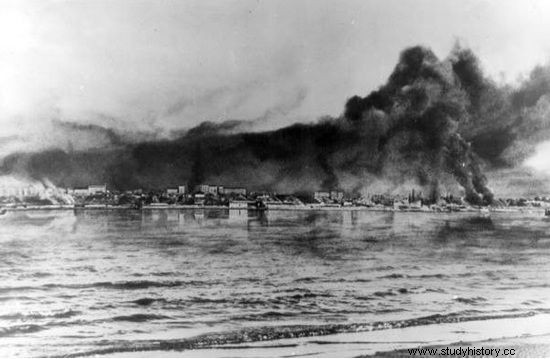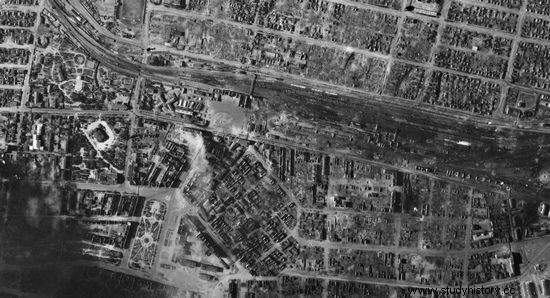The carpet raids are mainly associated with the Allied air offensive against the Third Reich. However, such bombings also took place on the Eastern Front. The largest of these took place on August 23, 1942. Stalingrad was the target and 40,000 people died as a result.
Sunday, August 23, 1942, was sunny and warm, so it is no wonder that the inhabitants of Stalingrad - looking for a respite from the heat pouring from the sky - crowded out on the Volga boulevards. Nobody informed them that German troops are only a few dozen kilometers from the city. As a result, hardly anyone was concerned about the announcement of the anti-aircraft alarm. After all, sirens have been wailing so many times and so far all the warnings have turned out to be false ... This time it was supposed to be completely different.
There will be a pile of rubble from Stalingrad
The commander of the German 4th Air Fleet, General Wolfram von Richthofen, had plans to repeat what he had done more than five years earlier with Guernica. This time, the scale of the entire operation was of course incomparably greater.
After all, the target was not a small Basque town, but a city with a population of over 600,000, named after Stalin himself. Richthofen, on the other hand, as Antony Beevor says in his classic book "Stalingrad" - had 1,200 bombers, which he intended to use to completely defeat the Russians.
It wasn't just bragging. The general assigned almost all planes of the 4th Air Fleet to perform the task. He threw over 1,000 bombers on the city:Heinkels He 111 and Junkers Ju 88 and Ju 87 Stuka. All this enormous aerial armada had arrived over Stalingrad around four o'clock in the afternoon. A hail of bombs started falling from the sky.

German aerial photo of the center of Stalingrad just before the bombing of the city on August 23, 1942.
Years later, the then teenage Yevgeny Silwestrov recalled that:
The whole sky was covered with planes. I've never seen so many of them at once before. They flew in small groups, and the sky was flecked with them to the horizon, like a patterned polka dot tablecloth or little flowers. And then, around 4:20 pm, there was a loud and shrill bang.
I saw huge mounds of black earth soaring into the sky. Windows were falling out of the windows, the doors were being torn from their hinges. A strong
wind started from nowhere. […] And the sour smell of smoke and burning was felt everywhere.
Scary scenes were taking place all over the metropolis. In addition to demolition bombs, the Germans also dropped incendiary bombs in huge numbers. In the south-west part of the city, where wooden buildings were dominant, a huge fire storm raged, consuming everything that stood in its way.
The situation in the center of Stalingrad was equally tragic. Thousands of people who had a picnic on the Mamayev Mound - the enormous Tatar mound towering over the city - had nowhere to hide. Even those who managed to reach the shelters and basements were not safe at all. Many of them were buried alive under collapsed buildings. In turn, on the banks of the river:
there were loads of people, including lots of children. They were all terrified - with the help of small paddles and with their bare hands, they tried to dig holes in the riverside sand where they could shelter from bullets and bombs. It was then that German planes flying low over the Volga mirror appeared. They came in groups, hanging over the shuttles that first bombed and then fired machine guns.
A day that will never be forgotten
The effects of the raid made a huge impression even on the commander of the Stalingrad Front, Colonel General Andrei Jeremience, who noted: No one will ever forget that day - it was a waking nightmare. We have gone through many things in this war, but this […] was something completely different.

During the 14-hour bombing, the Germans dropped nearly 1,000 tons of bombs on the city. Killing up to 40,000 people. Burning Stalingrad in the photo.
Of course, the Germans did not focus only on the residential part of the city. Industrial districts were also heavily bombed. Among other things, oil tanks located on the Volga River were hit. Their explosion caused the formation of a huge fireball, which rose almost 500 meters into the sky. The telephone exchange and the water supply station were also destroyed.
Chaos prevailed in the city, which was only aggravated by the decision of the authorities, which blocked a large part of the inhabitants from crossing the eastern bank of the river. Stalin decided that the presence of civilians would motivate soldiers to fight the approaching Wehrmacht units. One little boy was right and he aptly noted: Nobody cared about people. We were just cannon fodder .
The final result of the bombing that lasted nearly 14 hours was terrifying. The Germans dropped about 1,000 tons of demolition and incendiary bombs. According to official data, 40,000 civilians died in the city. A more conservative estimate is 25,000 victims.
Either way, it's hard to disagree with Alan Clarke, who made it clear that it was a purely terrorist raid, the purpose of which was to kill as many civilians as possible, paralyze all services, sow panic and doubt. To a large extent, the Germans managed to achieve this. At the same time, they suffered minimal losses. Only three planes failed to return to bases.

Photo of the center of Stalingrad taken by the Germans on August 30, 1942. You can see the huge amount of damage caused by the carpet raids.
However, the enormity of the devastation in the end turned against them. The city was completely impassable, and each ruined building became a fortress, defended by determined Red Army soldiers.
